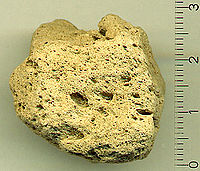
Photo from wikipedia
Abstract Basalt fiber (BF) is considered to be a green industrial material, exhibiting outstanding environmental stability along with superior mechanical properties compared to E-type glass fiber. It is also less… Click to show full abstract
Abstract Basalt fiber (BF) is considered to be a green industrial material, exhibiting outstanding environmental stability along with superior mechanical properties compared to E-type glass fiber. It is also less expensive than carbon fiber, making make it perfect for the mass-production of basalt fiber-reinforced polymer (BFRPs) composites. BFRPs are reinforced with nanomaterials to further enhance their performance. However, nanomaterials have the tendency to agglomerate because of their high surface energy, which hinders their efficient dispersion into the matrix. Hence, in this study, we grafted CNTs onto basalt fabric using chemical vapor deposition (CVD). Furthermore, CNT-grafted basalt fabric (BF-CNT) was sandwiched with epoxy via a hand lay-up technique. XRD, HR-RAMAN, FE-SEM, and thermogravimetric analysis (TGA) were performed to characterize BF-CNT. The properties of the fabricated BF-CNT/epoxy composites were also analyzed and compared with CNT-reinforced BF/epoxy composites. Based on our results, we found that the BF-CNT/epoxy composite shows improved properties.
Journal Title: Composites Science and Technology
Year Published: 2018
Link to full text (if available)
Share on Social Media: Sign Up to like & get
recommendations!